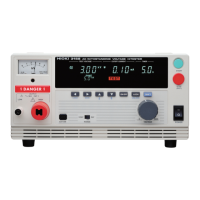17
────────────────────────────────────────────────────
2.10 Startup Inspection
────────────────────────────────────────────────────
2.10 Startup Inspection
To ensure safe testing, check the following before starting operation:
Breaking current
(1) Calculate the resistance based on the output voltage to be set and the upper level
value, and then provide a resistor suitable for the resistance.
(Output voltage
÷
Upper-level value (Breaking current) = Resistance)
A high-voltage resistor with a power rating larger than the power calculated
from the output voltage and resistance is recommended.
((Output voltage)
2
÷
Resistance
<
Power rating)
Ex.)
For the case that the output voltage is 2 kV and the upper level value is 4 mA,
Resistance value=2 kV
/
4mA
=
0.5 M
Ω
Rated power=(2 kV)
2
/
0.5 M
Ω=
8W
the 16 W resistor ((Rated power) x 2)) is recommendable to leave a margin.
Example high-voltage resistor:
KOA Corp.'s GS Series High Voltage High Resistance Thick Film Resistor
(2) Set an upper-level value.
(3) Connect the resistor to the test lead.
(4) Increase the output voltage beyond the set value, and make sure the current is
cut off (i.e., make sure the unit is in the FAIL state).
Analog voltmeter
(1) Before turning on the power, make sure the analog voltmeter is at 0 kV.
(2) If the voltage reading is not at zero, adjust the value to zero using a slotted
screwdriver.
Inter-lock
If the Inter-lock function is set, make sure the Inter-lock function works properly
before starting operation.
Key inspection
(1) Turn off the power, and unplug the power cord from the power outlet.
(2) For both the START and STOP keys on the front panel of the unit, press the
center of the key, and make sure you feel it click. The click is less noticeable
when the edges of the keys are pressed.
* Clicking
When a key is pressed slowly, there is a moment of slight resistance and a
feeling that the key cannot be pressed any further. When the key is pressed
further after this point, a clicking sensation can be felt.
(3) If you do not feel a click, the key may be broken.

